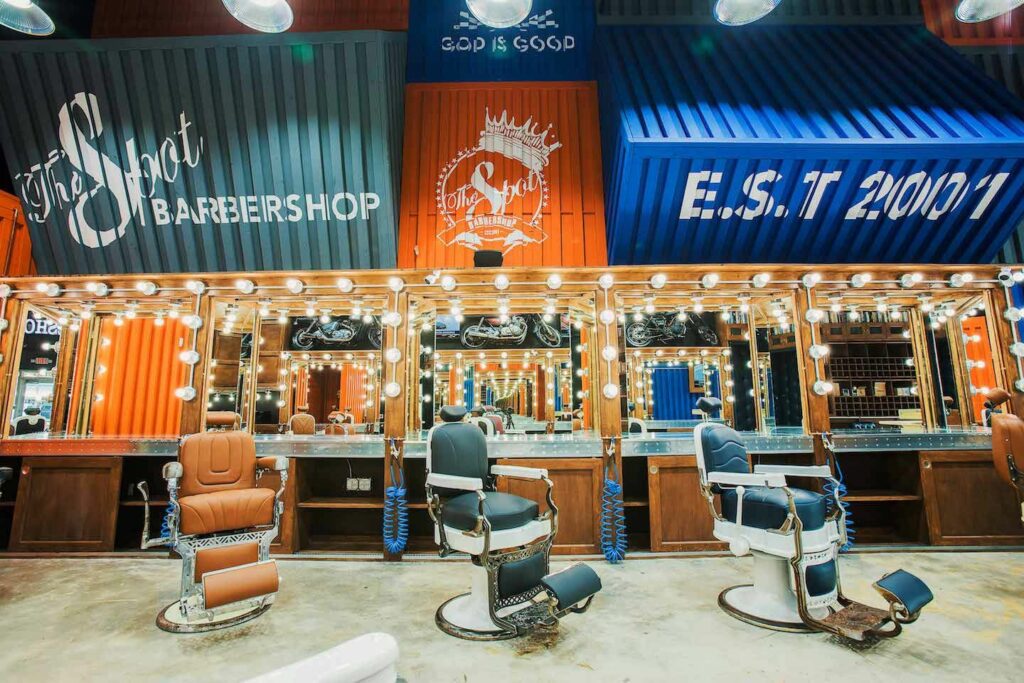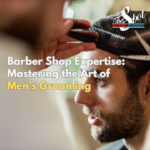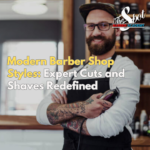Creating a Welcoming Space
In the world of barbering, the significance of interior design goes far beyond mere aesthetics. It’s about Creating a Welcoming Space that not only draws clients in but also keeps them returning. A well-designed barber shop acts as a sanctuary where style, comfort, and craftsmanship converge. This comprehensive guide explores the nuances of designing a barber shop that’s both modern and welcoming, ensuring your establishment stands out in the competitive grooming industry.
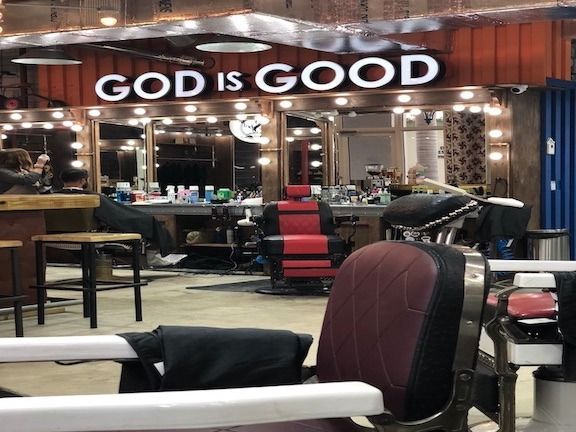
Integrating Technology in Design
Incorporating technology into your barber shop can streamline operations and enhance the customer experience. Features like online appointment booking, digital payment systems, and entertainment options like music or TV screens can add a modern touch. Even elements like USB charging stations can be a small but appreciated convenience for clients.
Importance of Comfort and Accessibility
Comfort is key in a barber shop. Ergonomic chairs for both clients and barbers, ample lighting, and a relaxing atmosphere are vital. Accessibility is another important aspect, ensuring that the shop is welcoming to all clients, including those with disabilities. Comfortable seating in waiting areas and a friendly, approachable layout can make a significant difference.
In barber shop design, prioritizing comfort and accessibility is essential for creating an inclusive and welcoming environment for all clients. Here are additional insights and strategies to enhance these aspects:
Ergonomic Design for All
Ergonomics is not just about the comfort of clients, but also about the health and efficiency of the barbers. Chairs, tools, and workstations should be designed to reduce strain and improve posture for the professionals working long hours. For clients, ergonomic chairs that offer proper support and can be adjusted for different body types are crucial.
Sensory Considerations
Comfort goes beyond the physical. It’s important for Creating a Welcoming Space that is sensory-friendly. This includes considering the acoustics of the shop to minimize noise, using gentle and calming lighting, and choosing materials that are pleasant to touch. For clients who are sensitive to sensory overload, such as those with autism, these considerations can make a significant difference.
Universal Design Principles
Incorporating universal design principles ensures that the barber shop is accessible and usable by everyone, regardless of age, ability, or status in life. This includes wide doorways, ramp access for wheelchairs and strollers, easily accessible service areas, and ADA-compliant restrooms.
Clear Signage and Navigation
Good signage is key to a welcoming environment. This includes clear, readable signs for restrooms, exits, price lists, and services offered. For clients who have visual impairments or cognitive disabilities, braille signage and high-contrast visuals can be helpful.
Comfortable Waiting Areas
Waiting areas should be more than just a place to sit. They should offer a comfortable and engaging experience. This includes offering a variety of seating options to accommodate different needs, providing reading materials, charging stations, and possibly a refreshment area with water, coffee, or tea.
Temperature and Air Quality
Maintaining a comfortable temperature and good air quality is essential. This can be achieved through proper ventilation, air conditioning, and heating systems. The use of air purifiers and plants can also improve the air quality and contribute to a more pleasant environment.
Inclusive Service Offerings
Comfort also extends to the services offered. This includes being mindful of different hair types and textures, offering a range of products that cater to various needs, and ensuring staff are trained to serve a diverse clientele.
Flexible Scheduling and Booking
Ease of booking and flexible scheduling options can greatly enhance client comfort and convenience. Online booking systems, clear communication about wait times, and the ability to easily reschedule appointments can make the experience more accommodating for busy clients.
Feedback and Adaptability
Finally, regularly seeking feedback from clients about their comfort and accessibility needs and being willing to adapt and make changes based on this feedback is crucial. This shows clients that their comfort and accessibility are truly valued.
By addressing these elements, barber shops can create an environment that is not just aesthetically pleasing, but truly welcoming and accessible to all. This approach not only enhances the client experience but also demonstrates a commitment to inclusivity and care, fostering loyalty and a positive reputation in the community.
Creating a Welcoming Space and Signature Style
Your barber shop’s design should reflect your brand’s identity and ethos. Are you going for a classic, retro vibe or a sleek, contemporary look? Elements such as wall art, color schemes, and décor items can help in forging a unique style that resonates with your clientele. Personal touches, like displaying local art or incorporating cultural motifs, can also add to the shop’s appeal.
Developing a signature style for a barber shop is crucial in establishing its identity and differentiating it from competitors. This style should resonate with the target clientele and reflect the ethos and personality of the business. Here are additional aspects to consider when crafting this unique style:
Storytelling Through Design
Every element in the barber shop should contribute to a cohesive narrative that reflects the brand’s story. This could involve elements that hint at the history of barbering, the personal journey of the owner, or the cultural context of the shop’s location. For example, a shop owned by a third-generation barber might include vintage photos and tools, evoking a sense of heritage and tradition.
Fusion of Styles
Combining different design styles can result in a unique and eclectic look. For instance, a blend of modern minimalism with rustic elements can create a warm yet contemporary space. The key is to balance these styles so that they complement rather than clash with each other, creating a harmonious and distinctive environment.
Custom Artwork and Murals
Incorporating custom artwork or murals can add a unique touch to a barber shop. Collaborating with local artists to create bespoke pieces not only supports the local art community but also provides a talking point for clients and a visually engaging element in the shop.
Signature Color Palette
A carefully chosen color palette can significantly impact the shop’s ambiance. The colors should align with the brand’s image—be it bold and vibrant, or subdued and sophisticated. Consistency in color usage throughout the shop, from the walls to the furnishings, helps in establishing a strong visual identity.
Lighting as a Design Element
Lighting is not just functional but also an important design element. It can be used to create mood, highlight certain areas, or accentuate design features. A mix of ambient, task, and accent lighting can add depth and character to the space.
Thematic Decor
Choosing a specific theme for the barber shop can make it memorable and appealing. Themes could be based on various concepts, like a particular era (e.g., 1920s speakeasy), a hobby (e.g., motorcycling), or even a cinematic style. The key is to implement the theme tastefully and subtly, ensuring it enhances rather than overwhelms the space.
Attention to Details
Details matter in creating a signature style. This includes the choice of barber chairs, the style of the reception desk, the type of mirrors used, and even smaller elements like the design of the menu of services or the style of the uniforms worn by the staff. These details should harmoniously blend into the overall design concept.
Brand Integration
The shop’s branding should be seamlessly integrated into the design. This includes the use of logos, brand colors, and thematic elements that reflect the brand’s identity. This consistency ensures that the brand is reinforced in every aspect of the customer’s experience.
Sensory Experience
A signature style is not just about visuals. Consider the other senses too. For example, a signature scent for the shop, a curated playlist that reflects the brand’s personality, or the choice of refreshments offered can all contribute to the overall experience and style of the shop.
By focusing on these elements, a barber shop can create a signature style that not only stands out but also provides an immersive and enjoyable experience for its clients. This signature style becomes a part of the shop’s brand, making it recognizable and memorable.
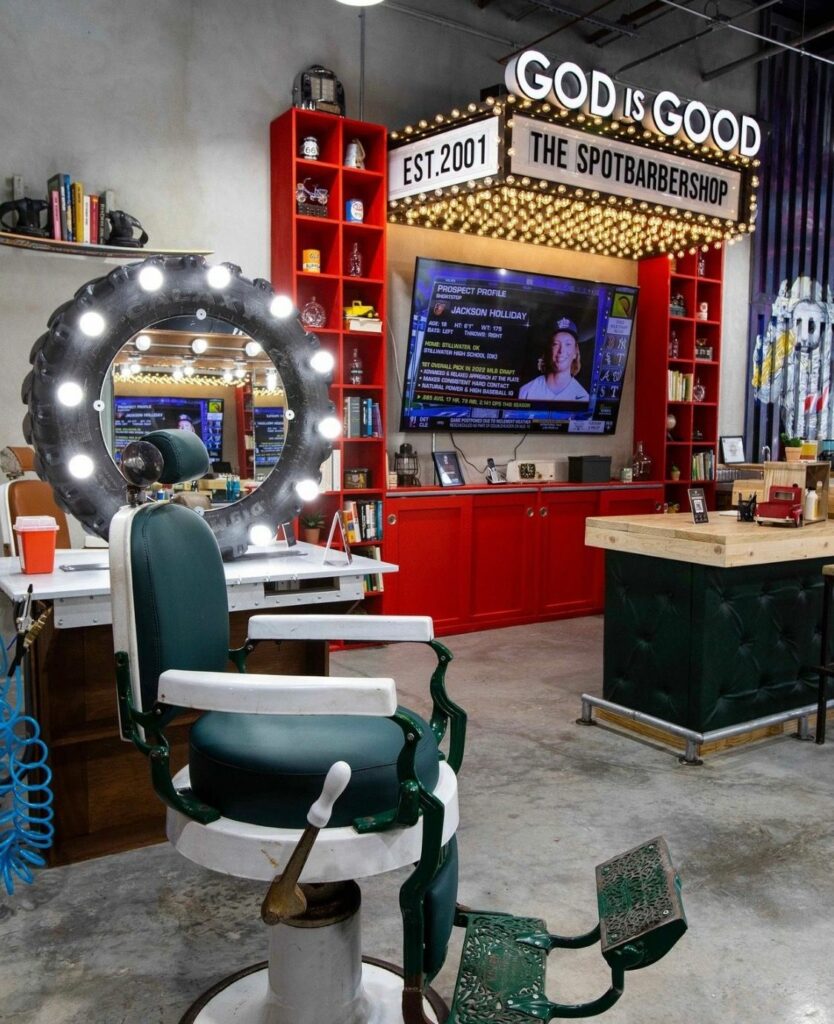
Understanding Modern Barber Shop Design Trends
Today, modern barber shop designs are a blend of style, functionality, and comfort. The use of sleek lines, a monochromatic color palette, and a focus on natural lighting are prevalent. Modern design also emphasizes open spaces that foster a sense of community and interaction. Additionally, the incorporation of elements like vintage barber chairs or industrial accents can add a unique character to the shop.
In the realm of modern barber shop design, the emphasis is on Creating a Welcoming Space that are not just functional, but also aesthetically pleasing and reflective of current trends. These trends are constantly evolving, driven by changing customer preferences, advances in design technology, and a growing emphasis on creating unique, memorable experiences.
Embracing Minimalism
One of the most prevalent trends in contemporary barber shop design is minimalism. This approach focuses on simplicity and the use of monochromatic color schemes, often with accents of natural materials like wood or stone. Minimalist designs favor clean lines, uncluttered spaces, and a focus on quality over quantity. This not only creates a relaxing environment for clients but also highlights the craftsmanship and professionalism of the barbers.
Industrial Chic
Another popular trend is the industrial chic aesthetic. This style combines raw, industrial elements like exposed brick, concrete floors, and metal fixtures with more refined and luxurious touches. The contrast between rough and smooth, old and new, creates a dynamic and visually interesting space that appeals to a clientele seeking a more edgy and urban experience.
Retro Revival
The retro revival trend sees barber shops harking back to the golden age of barbering. This includes the use of vintage barber chairs, antique mirrors, and classic barbering tools on display. The nostalgia associated with this style often brings a sense of comfort and timelessness, appealing to those who appreciate the heritage and tradition of barbering.
Biophilic Design
Increasingly, barber shops are incorporating elements of nature into their design—a concept known as biophilic design. This can include indoor plants, natural lighting, and the use of natural materials like wood and stone. This approach not only adds aesthetic value but also creates a calming, welcoming environment, improving both client and employee well-being.
Personalization and Brand Identity
Modern barber shops are also focusing on creating a unique brand identity through their design. This might involve bespoke artwork, custom-designed furniture, or a distinctive color palette that reflects the brand’s personality. Personalization makes a barber shop stand out and can be a key factor in attracting and retaining clients.
Incorporating Local Culture and Art
Incorporating local art and cultural elements into the design can give a barber shop a unique local flavor. This might include showcasing work from local artists, using locally sourced materials, or design elements that reflect the local community’s heritage and values.
Creating a Welcoming Space Utilization and Layout Planning
Whether dealing with a cozy corner shop or a spacious salon, effective use of space is crucial. A well-thought-out layout is essential for ensuring smooth operations and an enjoyable customer experience. Key considerations include the placement of barber chairs, waiting areas, product display shelves, and the reception desk. The aim is to create a flow that is both aesthetically pleasing and functional.
Historical Evolution of Barber Shop Design
The journey of barber shop design is as rich and varied as the history of barbering itself. From the classic red and white barber poles of yesteryear to the minimalist and chic designs of today, these spaces have evolved significantly. Initially, barber shops were straightforward and functional, catering mostly to basic grooming needs. However, as fashion and cultural trends evolved, so did the design of these establishments, mirroring societal shifts and preferences.
Sustainable and Eco-Friendly Practices
Adopting eco-friendly practices in your shop’s design is not only good for the environment but can also be appealing to customers. Use of sustainable materials, energy-efficient lighting, and implementing a recycling program are ways to demonstrate your commitment to sustainability. These practices can also help in reducing operational costs in the long run.
Conclusion: Joining The Spot Barber Academy
In conclusion, designing and Creating a Welcoming Space barber shop is an art that combines aesthetics, functionality, and customer experience. It’s about Creating a Welcoming Space where clients feel relaxed and valued. For those aspiring to excel in this craft, The Spot Barber Academy offers a comprehensive Barbering program that goes beyond teaching cutting and styling skills. Our program delves into the principles of shop design, business management, and customer service, equipping you with the knowledge to not only be an excellent barber but also a successful shop owner. Join us at The Spot Barber Academy, where your journey to becoming a master in the art of barbering begins.
